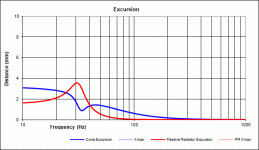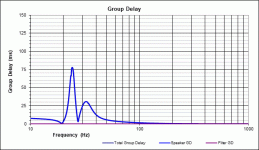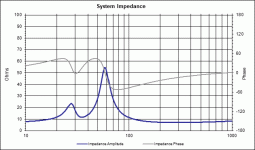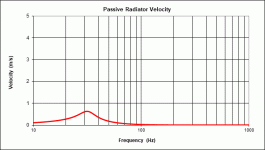I keep returning back to this article from Jeff which I am just enamoured by - what are the tricks for modelling your own version? I'm thinking about a smaller ~7litre cab based on the Purifi PTT4.0 and matching passive radiator.
https://www.facebook.com/groups/DIYLoudspeakerProjecPad/posts/815713518784487/
Helios Part 12 – Bass Alignment with Passive Radiator
The target for the Helios was a slightly larger than normal stand mounted monitor. The front baffle is just barely larger than the woofer is wide and just taller than the woofer and waveguide together are tall. The depth ended up being slightly deeper than the width of the SB29 passive radiator. So, there really isn’t a lot of excess size here. The internal volume is approximately 35 liters.
When working with a speaker this size with a larger woofer like the Satori WO24 the bass alignment becomes tricky. To compound the situation, the Qts of the woofer with wiring comes in at .42, and a Qts this high pushes up the required volume of the cabinet quite a bit from low Qts drivers. The 35 liters works out to sealed Qtc right at .7, which is maximally flat with the lowest F3 for a sealed alignment. Of course we might be able to get deeper bass from the speaker vented, but there’s two problems with that – First, the volume is too small for a bass alignment that does not possess some level of peaking. The peaking however, might not be considered objectionable by most people since it would be a broad smooth rise, but it’s still not flat. And second, the required port diameter for the WO24 would result in a port too long to work with this enclosure effectively.
This brings us to using a passive radiator. While it is possible to use a passive radiator to tune this enclosure to the optimum target of 25 Hz, there are still two issues that I didn’t like. First, there is still the hump in the midbass due to the small volume alignment, and second, the Fs of the radiator is higher resulting in a response that is dropping faster than 24 dB/oct below 40 Hz, despite this we have an F3 of 40 Hz and an F6 of 32. Also, with this alignment the cone is reaching an excursion of 17.5 mm at 20 Hz with 100 Watts of power.
My solution was to do something I came up with on the Testarossas that proved to be more successful than I expected. I called it at the time a Quasi-Transmission Line loading. I called it this because both the impedance curve and the box response curve were nearly identical to what you get with a heavily damped transmission line. This was accomplished by using a passive radiator that tunes the enclosure to a very low frequency, even below 20 Hz. The reason it worked really well on the Testarossa was because I found that this type of tuning worked miracles on controlling cone travel, and the MW16P woofers have a very compliant suspension and this additional control was a great benefit, as the cones stayed under control instead of bouncing around excessively.
Now, the more advanced guys are saying – But sealed will control the cone travel too by using the closed box air compliance to push back against the cone. True, but this passive radiator hybrid beats sealed. Here’s the comparison.
In the sealed box with the Qtc of .7 the system has an F6 of 36.7 Hz and an F10 28.0 Hz. Using our 100 watts of input power the driver excursion rises to 14 mm at about 20 Hz and below, against an Xmax of 9 mm. And typical to sealed systems with a Q of .7 the response is flat with a 12 dB/oct roll-off beginning at just below 50 Hz.
Using the SB29NRX-00 radiator right out of the box tunes the enclosure to 17.8 Hz. The cone response exactly follows that of the sealed system with a flat response with no peaking and a 12 dB/oct roll-off until we begin to approach the tuning frequency. The radiator output is not real high, but it does sum with the cone to produce an F6 of 33.5 Hz and an F10 of 25.4 Hz. System response is now rolling off at 8-9 dB/octave (you read that right) giving the system 4 dB more output at 20 Hz compared to sealed with no peaking. The more gradual roll-off matches very well with the rising room response of most rooms in this range yielding a system whose in-room response is very flat and extended to 30 Hz and below (for a stand mounted monitor just over one cubic foot in volume). Excursions? With the passive radiator and low tuning, the woofer’s excursions peak at 11.9 mm at 35 Hz with 100 Watts, but then below that begin to drop off to only 3.5mm at 17 Hz and doesn’t exceed Xmax again until 14 Hz and below. And for those wondering, Group Delay with this passive radiator and the low tuning is only 11 mSec at 20 Hz, which is very low as well.
Using the mass loaded passive radiator to control the cone motion of the woofer to very low frequencies not only adds a few dB of output in the deep bass, helping to extend it, and match the room curve better, it is also keeps the voice coil better centered in the gap to much higher power levels, resulting in even lower distortion from the woofer at low frequencies.
I attempted to make the Helios a very unique, near state of the art loudspeaker in the category of a stand mounted monitor, combining flat response, matched and controlled directivity, smooth extended bass, and low distortion – combined with fairly high output level. I wanted it to be as accurate of a reproducer as was possible to make using passive components, and I believe it will be tough to beat this one overall.
Thanks
https://www.facebook.com/groups/DIYLoudspeakerProjecPad/posts/815713518784487/
Helios Part 12 – Bass Alignment with Passive Radiator
The target for the Helios was a slightly larger than normal stand mounted monitor. The front baffle is just barely larger than the woofer is wide and just taller than the woofer and waveguide together are tall. The depth ended up being slightly deeper than the width of the SB29 passive radiator. So, there really isn’t a lot of excess size here. The internal volume is approximately 35 liters.
When working with a speaker this size with a larger woofer like the Satori WO24 the bass alignment becomes tricky. To compound the situation, the Qts of the woofer with wiring comes in at .42, and a Qts this high pushes up the required volume of the cabinet quite a bit from low Qts drivers. The 35 liters works out to sealed Qtc right at .7, which is maximally flat with the lowest F3 for a sealed alignment. Of course we might be able to get deeper bass from the speaker vented, but there’s two problems with that – First, the volume is too small for a bass alignment that does not possess some level of peaking. The peaking however, might not be considered objectionable by most people since it would be a broad smooth rise, but it’s still not flat. And second, the required port diameter for the WO24 would result in a port too long to work with this enclosure effectively.
This brings us to using a passive radiator. While it is possible to use a passive radiator to tune this enclosure to the optimum target of 25 Hz, there are still two issues that I didn’t like. First, there is still the hump in the midbass due to the small volume alignment, and second, the Fs of the radiator is higher resulting in a response that is dropping faster than 24 dB/oct below 40 Hz, despite this we have an F3 of 40 Hz and an F6 of 32. Also, with this alignment the cone is reaching an excursion of 17.5 mm at 20 Hz with 100 Watts of power.
My solution was to do something I came up with on the Testarossas that proved to be more successful than I expected. I called it at the time a Quasi-Transmission Line loading. I called it this because both the impedance curve and the box response curve were nearly identical to what you get with a heavily damped transmission line. This was accomplished by using a passive radiator that tunes the enclosure to a very low frequency, even below 20 Hz. The reason it worked really well on the Testarossa was because I found that this type of tuning worked miracles on controlling cone travel, and the MW16P woofers have a very compliant suspension and this additional control was a great benefit, as the cones stayed under control instead of bouncing around excessively.
Now, the more advanced guys are saying – But sealed will control the cone travel too by using the closed box air compliance to push back against the cone. True, but this passive radiator hybrid beats sealed. Here’s the comparison.
In the sealed box with the Qtc of .7 the system has an F6 of 36.7 Hz and an F10 28.0 Hz. Using our 100 watts of input power the driver excursion rises to 14 mm at about 20 Hz and below, against an Xmax of 9 mm. And typical to sealed systems with a Q of .7 the response is flat with a 12 dB/oct roll-off beginning at just below 50 Hz.
Using the SB29NRX-00 radiator right out of the box tunes the enclosure to 17.8 Hz. The cone response exactly follows that of the sealed system with a flat response with no peaking and a 12 dB/oct roll-off until we begin to approach the tuning frequency. The radiator output is not real high, but it does sum with the cone to produce an F6 of 33.5 Hz and an F10 of 25.4 Hz. System response is now rolling off at 8-9 dB/octave (you read that right) giving the system 4 dB more output at 20 Hz compared to sealed with no peaking. The more gradual roll-off matches very well with the rising room response of most rooms in this range yielding a system whose in-room response is very flat and extended to 30 Hz and below (for a stand mounted monitor just over one cubic foot in volume). Excursions? With the passive radiator and low tuning, the woofer’s excursions peak at 11.9 mm at 35 Hz with 100 Watts, but then below that begin to drop off to only 3.5mm at 17 Hz and doesn’t exceed Xmax again until 14 Hz and below. And for those wondering, Group Delay with this passive radiator and the low tuning is only 11 mSec at 20 Hz, which is very low as well.
Using the mass loaded passive radiator to control the cone motion of the woofer to very low frequencies not only adds a few dB of output in the deep bass, helping to extend it, and match the room curve better, it is also keeps the voice coil better centered in the gap to much higher power levels, resulting in even lower distortion from the woofer at low frequencies.
I attempted to make the Helios a very unique, near state of the art loudspeaker in the category of a stand mounted monitor, combining flat response, matched and controlled directivity, smooth extended bass, and low distortion – combined with fairly high output level. I wanted it to be as accurate of a reproducer as was possible to make using passive components, and I believe it will be tough to beat this one overall.
Thanks
Attachments
-
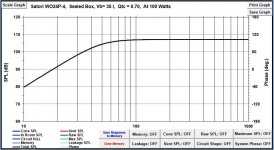 58057671_578020832677351_3423586605657489408_n.jpg56 KB · Views: 156
58057671_578020832677351_3423586605657489408_n.jpg56 KB · Views: 156 -
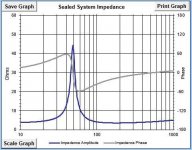 57306006_578020812677353_8753046514915344384_n.jpg28.9 KB · Views: 158
57306006_578020812677353_8753046514915344384_n.jpg28.9 KB · Views: 158 -
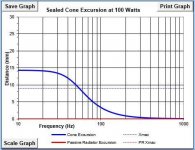 57180239_578020819344019_7809472612647567360_n.jpg27.7 KB · Views: 156
57180239_578020819344019_7809472612647567360_n.jpg27.7 KB · Views: 156 -
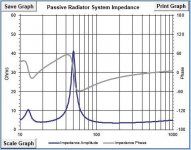 57614992_578020766010691_6727248623374958592_n.jpg29.7 KB · Views: 168
57614992_578020766010691_6727248623374958592_n.jpg29.7 KB · Views: 168 -
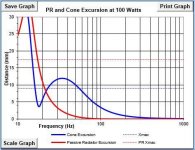 57368805_578020779344023_4736819757452361728_n.jpg31.2 KB · Views: 168
57368805_578020779344023_4736819757452361728_n.jpg31.2 KB · Views: 168 -
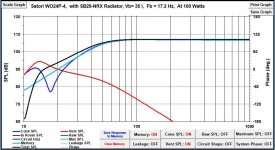 57286205_578020772677357_5038974258663915520_n.jpg63.1 KB · Views: 176
57286205_578020772677357_5038974258663915520_n.jpg63.1 KB · Views: 176 -
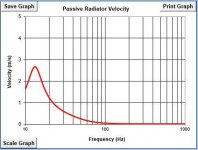 57882625_578020719344029_478060586240835584_n.jpg22.7 KB · Views: 148
57882625_578020719344029_478060586240835584_n.jpg22.7 KB · Views: 148 -
 57098966_578020709344030_5359150541433733120_n.jpg26.5 KB · Views: 159
57098966_578020709344030_5359150541433733120_n.jpg26.5 KB · Views: 159 -
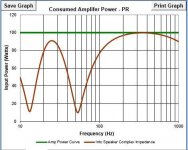 57187563_578020722677362_5802316382410375168_n.jpg26.3 KB · Views: 159
57187563_578020722677362_5802316382410375168_n.jpg26.3 KB · Views: 159
Looks like some sort of EBS (extended bass shelf) alignment, but with passive radiator instead of a vent.
Nothing new under the sun.
Nothing new under the sun.
Yes, that looks more or less what Jeff (RIP) was aiming for; assuming the driver can manage it, a low tuned EBS alignment of any kind can be very effective and sometimes equal the GD of a sealed box. Jeff appears to have juggled box volume & PBR type / mass to provide a tuning that tracks an initial Butterworth response & slowly transitions to a mild, low-tuned EBS type shape. I haven't time right now to check to see if that is feasible with the Purifi units as it will require particular properties, but I suspect something akin might be.
Find Curt Campbell's site. Read his article about tuning BR boxes sized at the sealed 'ideal'.
Jeff's method is the PR version.
Both are good models of what some of us found by 'trial by error' long ago, but did not understand.
Jeff's method is the PR version.
Both are good models of what some of us found by 'trial by error' long ago, but did not understand.
Looking at the Helios and the Helios CM, it’s a shame Jeff never got to try an iteration using Purifi drivers and a more optimized waveguide. When I look at the Helios polars, it looks like the waveguide was used to lower the crossover point and match power response; directivity and baffle width/edge treatments look a bit disregarded. A program like ATH could generate a much better waveguide, such as a standalone with better directivity.
Aperiodic dampening does a similar thing and is something I employ in almost every speaker I build. The difference between the two methods of cone control in terms of quality of bass are audible to me. The PR version sounds less controlled and is more sensitive to room placement depending on the location of the PR. Because the PR may become more or less coupled to the room, it greatly affects the system response and shifts the box tuning frequency, further makimg the system more sensitive to room placement.
A critically tuned PR systen will in theory be better at controlling the cone statically way down low thanks to the PR's mass and the airtight seal mimicking a sealed box with very compliant walls. This of course depends on how far down low the PR is tuned and the loss of the system. Aperiodic venting just becomes a big air leak and will leave the woofer statically uncontrolled. If your source and amplification is DC coupled and has a very low rolloff frequency, playing vinyl can be a challenge with very high compliance drivers. The critically tuned PR setup would work better to keep the cone from walking around and sending IM distortion through the roof.
A critically tuned PR systen will in theory be better at controlling the cone statically way down low thanks to the PR's mass and the airtight seal mimicking a sealed box with very compliant walls. This of course depends on how far down low the PR is tuned and the loss of the system. Aperiodic venting just becomes a big air leak and will leave the woofer statically uncontrolled. If your source and amplification is DC coupled and has a very low rolloff frequency, playing vinyl can be a challenge with very high compliance drivers. The critically tuned PR setup would work better to keep the cone from walking around and sending IM distortion through the roof.
Assuming the PTT4.0X08 & about 1/2ohm series R for wire-loop, connection (& if relevent series component) losses, then depending on damping, box leakage &c. 7 litres sealed is going to be in the Qtc = 0.5 region. With the PTT4.0PR, in the same volume, it should approximately track that response to about 90Hz, below which it will have around 3dB more output until it unloads in the low 30s. Not quite what Jeff intended I suspect, and the PBR excursion is fairly high if you have programme material with significant LF energy. Not bad for a little 'un though.
This is something I was wondering about some years back and posted about it here. I knew it must have been done before and the best (IMO) answer pointed towards the Cordell Equalized Quasi-Sealed System (EQSS), save without the use of EQ.
Thanks everyone - I really enjoyed reading the infromation sources provided. The article on Kurt Campbells site was interesting.
I tried using Jeffs/Charles Woofer box and circuit designer software to try an model a PTT4.0 in this type of configuration, but unfortunately the excel spreadsheet doesn't work so well anymore, even in Office 2004.
I tried using Jeffs/Charles Woofer box and circuit designer software to try an model a PTT4.0 in this type of configuration, but unfortunately the excel spreadsheet doesn't work so well anymore, even in Office 2004.
Works fine for me, in Office 2010 & 2019 so you may have some kind of conflict going on. I wouldn't be entirely surprised as I can't get frd response blender to work; it just kicks out a circular reference warning every time I open it.
I suggest you keep context in mind for this one. The primary use of passive radiators is as a substitute for a vent when, for a given Vb and tuning, a conventional duct would be of impractical size -either too small a cross-section, increasing airflow velocity in the duct, or excessively long, making it difficult to physically fit in the box and / or run into problems with harmonic modes (ducts are 1/2 wave resonators). In the case of Helios, he had an acoustically small volume, so ducting was impractical, but he wanted a bit more output than he'd get with the driver in a straightforward sealed volume. Hence this particular alignment, where he was able to juggle Vb and tuning so he could initially track a Butterworth sealed alignment, but progressively transition via low-tuned PBR to grabbing a bit more output until it finally unloads. That tends to work quite well with drivers like W024, since they want a moderate Vb when effective Q (Qts + series R) is accounted for, and a low tuning. If you have a driver that doesn't need a particularly large box in the first place, it doesn't become moot exactly, but it loses some of its purpose. The above (which I actually roughed out in Jeff's WB&CD) initially tracks a Qtc = 0.5 alignment rather than a Butterworth (it would be quite small otherwise), before the PBR starts to provide a bit more gain. It's not refined & isn't meant to be as I only had a few minutes; no doubt something a bit better could be done, but whether, broadly speaking, this type of design / alignment would more effective than an alternative using these particular drivers is another matter though. YMMV as always on that one. 😉
I suggest you keep context in mind for this one. The primary use of passive radiators is as a substitute for a vent when, for a given Vb and tuning, a conventional duct would be of impractical size -either too small a cross-section, increasing airflow velocity in the duct, or excessively long, making it difficult to physically fit in the box and / or run into problems with harmonic modes (ducts are 1/2 wave resonators). In the case of Helios, he had an acoustically small volume, so ducting was impractical, but he wanted a bit more output than he'd get with the driver in a straightforward sealed volume. Hence this particular alignment, where he was able to juggle Vb and tuning so he could initially track a Butterworth sealed alignment, but progressively transition via low-tuned PBR to grabbing a bit more output until it finally unloads. That tends to work quite well with drivers like W024, since they want a moderate Vb when effective Q (Qts + series R) is accounted for, and a low tuning. If you have a driver that doesn't need a particularly large box in the first place, it doesn't become moot exactly, but it loses some of its purpose. The above (which I actually roughed out in Jeff's WB&CD) initially tracks a Qtc = 0.5 alignment rather than a Butterworth (it would be quite small otherwise), before the PBR starts to provide a bit more gain. It's not refined & isn't meant to be as I only had a few minutes; no doubt something a bit better could be done, but whether, broadly speaking, this type of design / alignment would more effective than an alternative using these particular drivers is another matter though. YMMV as always on that one. 😉
Give me ten, I'll have to re-do it. By the way, if you're having issues with WB&CD, try running it in Excel's compatability mode (depending on which version of Excel you're running), which can sometimes solve issues.
Apologies -slightly more than 10. Things cropped up that I was not expecting.
OK, as noted what I quickly looked at was assuming the PTT4.0-X08 & the PTT4.0PR. If you're running WB&CD, insert the usual 0.5ohm series R for typical conservative wire, connection & passive series XO components. 6.8 litres, Qa = 40 which will approximate non-opposing surface lagging with an effective material like OC-703, SAE-F10 etc., Ql = 15 for a reasonably well-built box with little leakage. No additional mass on the PBR. Approximately tracks the initial rolloff of a Qtc = 0.5 box down to about 80Hz-90Hz below which the PBR starts to provide extra gain. Not the same alignment as Jeff used, to get closer to that you'd need a smaller box & add mass to the PBR. But it's vaguely akin in terms of low tuning a PBR design which initially (approximately) tracks a given sealed alignment.
OK, as noted what I quickly looked at was assuming the PTT4.0-X08 & the PTT4.0PR. If you're running WB&CD, insert the usual 0.5ohm series R for typical conservative wire, connection & passive series XO components. 6.8 litres, Qa = 40 which will approximate non-opposing surface lagging with an effective material like OC-703, SAE-F10 etc., Ql = 15 for a reasonably well-built box with little leakage. No additional mass on the PBR. Approximately tracks the initial rolloff of a Qtc = 0.5 box down to about 80Hz-90Hz below which the PBR starts to provide extra gain. Not the same alignment as Jeff used, to get closer to that you'd need a smaller box & add mass to the PBR. But it's vaguely akin in terms of low tuning a PBR design which initially (approximately) tracks a given sealed alignment.
Attachments
Jeffs WB&CD works fine on a Windows laptop and Office 2016, but it doesn't like Office 360 on a Macbook... Draft in progress attached.
The pre-completed Satori WO24P-4 entry on the woofer tab has an Vb of 68... indicating that Jeff modelled this with a Qts of 0.4?
Just trying to work out the right Vb and Fb parameters to enter for PTT4.0...
I also have an error on 'Mass needed' for Passive Rad.
The pre-completed Satori WO24P-4 entry on the woofer tab has an Vb of 68... indicating that Jeff modelled this with a Qts of 0.4?
Just trying to work out the right Vb and Fb parameters to enter for PTT4.0...
I also have an error on 'Mass needed' for Passive Rad.
Attachments
Jeff notes he used a Qts of 0.42 in the short piece you quote above, to account for series R from wiring (inc. passive components etc.).
Your 'mass needed' error is a result of the data entry in the 'added mass box' below, which is currently set to -50. Change it to '0'.
As noted, the PTT4.0 isn't really ideal for this sort of alignment, which Jeff appears to have created as a means of getting a bit more output with that driver in a compact box than he would have got if he ran it sealed (vented requiring a significantly larger cabinet).
Without paying any attention to alignment as such (I've a paper to finish writing in a moment) as a 'get you started', ensure you've got all the relevant driver data and 0.5ohms series R entered, enter in a Vb of 7 litres (I only used this because you mentioned it earlier & I've no time to look at it properly) set Ql to 15 and Qa to 40. Adjusting 'desired Fb' to 33.3Hz, you should find the 'mass needed' box then lines up to 0 (i.e. no added mass, again because I don't have time to look at anything properly). That should get you going, with a working initial data entry set.
Your 'mass needed' error is a result of the data entry in the 'added mass box' below, which is currently set to -50. Change it to '0'.
As noted, the PTT4.0 isn't really ideal for this sort of alignment, which Jeff appears to have created as a means of getting a bit more output with that driver in a compact box than he would have got if he ran it sealed (vented requiring a significantly larger cabinet).
Without paying any attention to alignment as such (I've a paper to finish writing in a moment) as a 'get you started', ensure you've got all the relevant driver data and 0.5ohms series R entered, enter in a Vb of 7 litres (I only used this because you mentioned it earlier & I've no time to look at it properly) set Ql to 15 and Qa to 40. Adjusting 'desired Fb' to 33.3Hz, you should find the 'mass needed' box then lines up to 0 (i.e. no added mass, again because I don't have time to look at anything properly). That should get you going, with a working initial data entry set.
Thanks Scott... spot on advice & progress made.
Qts of the PT4.0 is 0.3, so I've amended to that.
So the basics are now modelled, its now just case of working out how to make FR maximally flat and controlling excursion - a bit like the problems Jeff first described before implementing his 'Quasi-Transmission Line loading' alignment.
Switch from the Purifi PR to the SB15SFCR like Jeff used in his Revolution Mini, and FR is flat, but F3 ~ 55Hz, so kinda defeats purpose.
Aim: Maximally flat FR in a small box 🙂
Qts of the PT4.0 is 0.3, so I've amended to that.
So the basics are now modelled, its now just case of working out how to make FR maximally flat and controlling excursion - a bit like the problems Jeff first described before implementing his 'Quasi-Transmission Line loading' alignment.
Switch from the Purifi PR to the SB15SFCR like Jeff used in his Revolution Mini, and FR is flat, but F3 ~ 55Hz, so kinda defeats purpose.
Aim: Maximally flat FR in a small box 🙂
Attachments
I think you've run into a bit of a disconnect. From the above, you say 'Aim: maximally flat FR in a small box' but directly above that, you note you tried a different PBR and achieved a flat response, but didn't like the 55Hz F3, stating that it 'defeats the purpose'. From that, it sounds like what you are really trying to achieve is have a very flat response to a very low frequency (with a PBR). Now, that wasn't quite Jeff's aim, and you'll struggle to achieve it with the Purifi midbass -it doesn't really suit that sort of alignment, as it's fundamentally a lower Q driver with a higher Fs.
I suggest you go back & reread what Jeff did. Short version: he wanted to make a standmount with the W024, and his size limit was 35 litres. That meant a regular vented alignment was out: the driver needs a bigger box for that. However, 35 litres provides a Butterworth (maximally flat sealed) alignment. He could have left it like that, but with careful selection, a low-tuned PBR allowed him, in the same volume, to grab a bit more gain on the bottom end, without resulting in any peaking in the response above. The response shape is a little akin to an EBS vented, and to a point, has similar objectives, although it doesn't really behave like a TL, given that 55ohm upper peak. In essence, it's an interesting solution to a given problem (i.e. a limited cabinet volume). That's not really an issue with the Purifi midbass, and your main reason for using a PBR in its case would be the usual one for using them: if you ran it vented, you'd struggle to balance air velocity through the duct with excessive pipe resonances.
I suggest you go back & reread what Jeff did. Short version: he wanted to make a standmount with the W024, and his size limit was 35 litres. That meant a regular vented alignment was out: the driver needs a bigger box for that. However, 35 litres provides a Butterworth (maximally flat sealed) alignment. He could have left it like that, but with careful selection, a low-tuned PBR allowed him, in the same volume, to grab a bit more gain on the bottom end, without resulting in any peaking in the response above. The response shape is a little akin to an EBS vented, and to a point, has similar objectives, although it doesn't really behave like a TL, given that 55ohm upper peak. In essence, it's an interesting solution to a given problem (i.e. a limited cabinet volume). That's not really an issue with the Purifi midbass, and your main reason for using a PBR in its case would be the usual one for using them: if you ran it vented, you'd struggle to balance air velocity through the duct with excessive pipe resonances.
Hi Scott - once again, thanks for your insight.
I gave Helios as an example, but what I’m trying to ‘mimic’ is actually his Revolution mini, but using the Purifi PTT4.0.
Now I might have put 2+2 together and made 5 as I’m a novice, but I presumed that Jeff had used the same alignment in the Revolution mini? Perhaps not… as he states it was only flat to 50Hz, which is similar ball park as what I’d calculated before room gain. SB15CAC has similar Fs and Qts as the Purifi, so I thought I play around with it.
Perhaps the lesson to be learnt is if I try to replicate a model of the Helios, this way I’ll understand the alignment better.
One thing I don’t get is how to extend the FR in the PTT example, and tame/prevent the excessive excursion on the bottom end.
I gave Helios as an example, but what I’m trying to ‘mimic’ is actually his Revolution mini, but using the Purifi PTT4.0.
Now I might have put 2+2 together and made 5 as I’m a novice, but I presumed that Jeff had used the same alignment in the Revolution mini? Perhaps not… as he states it was only flat to 50Hz, which is similar ball park as what I’d calculated before room gain. SB15CAC has similar Fs and Qts as the Purifi, so I thought I play around with it.
Perhaps the lesson to be learnt is if I try to replicate a model of the Helios, this way I’ll understand the alignment better.
One thing I don’t get is how to extend the FR in the PTT example, and tame/prevent the excessive excursion on the bottom end.
Maybe we from the PURIFI team can help. we are developing a box tuning optimization tool that includes PR alignment - it’s a bit more complex than sealed and ported and text book prototypes are scarce.
Common for ported and PR: the only driver parameter that determines the shape of the response is Qts. Vas is then just scaling the box volume and fs is scaling the corner frequency. Low Qts needs a smaller box than Vas and higher Qts a bigger. You can increase Qts by adding some series resistance - this can be necessary to get a very flat bass response with little droop. It will typically also be necessary to hit an exact box volume and adjust the PR mass (like trimming the port length).
As for our tool: you specify how much bass roll off you can accept (FR drop at fs) and the tool finds the alignment with the best impulse response that meets the requirement.
Common for ported and PR: the only driver parameter that determines the shape of the response is Qts. Vas is then just scaling the box volume and fs is scaling the corner frequency. Low Qts needs a smaller box than Vas and higher Qts a bigger. You can increase Qts by adding some series resistance - this can be necessary to get a very flat bass response with little droop. It will typically also be necessary to hit an exact box volume and adjust the PR mass (like trimming the port length).
As for our tool: you specify how much bass roll off you can accept (FR drop at fs) and the tool finds the alignment with the best impulse response that meets the requirement.
- Home
- Loudspeakers
- Multi-Way
- Jeff Bagby's 'Quasi-Transmission Line loading'
